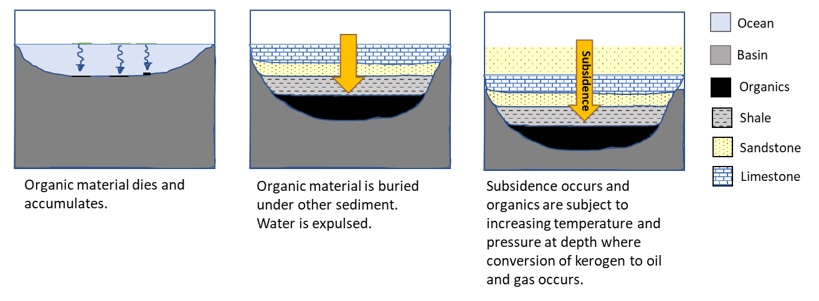
Several geologic processes must occur at the right time and place in order for a working petroleum system to form. A working petroleum system is an area where genetically related hydrocarbon has gathered in a reservoir and been trapped. Specifically, source, reservoir, trap, seal, and migration must all have appropriate characteristics and timing of events for a petroleum system to successfully develop. The first step in creating a petroleum system is the creation of hydrocarbon. We refer to this as the hydrocarbon kitchen, where oil and gas are ‘cooked up’.
All hydrocarbon originates from organic matter accumulating, being buried, and eventually undergoing increases in temperature and pressure. The environment of deposition affects the type of source rock and later on the type of hydrocarbon that is created. For instance, lakes, oceans, and rivers favor accumulations of different types of organic remains. Lakes tend to have a high degree of algae, oceans are dominated by plankton, and rivers carry a lot of terrigenous plant material. The degree of oxygenation is generally lesser in deeper marine environments, and greater in tidal, delta, or river environments. The source rock type affects whether a lighter oil or gas or heavier oil is more likely to be created.
Tectonic events also impact source development. As sediments are buried to greater and greater depths, temperature and pressure increase. The ‘cooking’ of the hydrocarbon progresses, also known as thermal maturity. Heavy oil is sometimes considered ‘under-cooked’ or immature. Heavier oil can be difficult to produce because it is less moveable than lighter oil and may require heating, mining, or various flooding techniques. As temperature and pressure increase, lighter and lighter oils are generated until phase transition to wet gas and eventually dry gas occurs. While gas has some benefits over oil, such as a higher recovery rate, it also can deliver a lower market price due to decreased energy content and is sometimes considered ‘over-cooked’ or over-mature. Hydrocarbon all along the range of maturity is marketable and useful, but profits depend on the market conditions in the area of the particular oil and gas opportunity. Proximity to markets and refineries, and whether lighter or heavier endmembers are desirable in your area are important factors when considering the profitability of your particular asset.
The figure below is a simplified cartoon demonstrating how organics can be deposited, buried, and subjected to increasing temperature and pressure through further subsidence (sinking packages of rock). The temperatures and pressures reached as well as the type of source originally deposited all contribute to the phase and characteristics of the hydrocarbon generated.

Source rock characteristics have many implications for oil and gas production. They impact the phase of hydrocarbon, maturity, pressure, refining and processing required, producibility, and market price. Mapping hydrocarbon kitchens and understanding source rock characteristics is therefore very important when delineating a working petroleum system. Note that the current depth of a source bed may not be the depth it was at when hydrocarbon was actively being generated, so paleoreconstruction (reconstructing the depth the bed was at during different times) is critical, and can be related to maximum temperatures and therefore maturity. Mapping other source rock data is also important. Total organic carbon is often used to quantify the quality of source rock because it gives an indication of the concentration of the source. Vitrinite reflectance (a measurement of how light reflects off certain rock particles that correlates to maturity) and geochemical analysis of kerogen can also help us understand source rock type and thermal maturity. We’ve discussed how source rock is formed, how source rock characteristics feed into profitability, and how mapping source rock is critical for delineation of a working petroleum system. Next, we’ll discuss other elements of the petroleum system.

Recent Comments